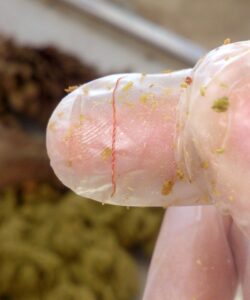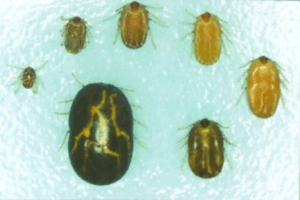Read the latest information on
Foot-and-mouth disease
As spring arrives, bringing warmer weather and lush pastures, it also ushers in a surge of parasitic activity that can pose serious health risks to your cattle. While new life flourishes on the farm, so too do parasites that thrive in moist, warm conditions, such as worms and ticks. Understanding these threats and implementing timely management strategies is key to maintaining herd health.
Young cattle with underdeveloped immune systems are particularly vulnerable to worm infections, making worm control essential during spring calving.
Roundworms are the most significant internal parasites affecting cattle. They have long, complex lifecycles involving a period on pasture.
Key species include:

Figure 1. Adult barber’s pole worm, Haemonchus contortus, on a finger to indicate size.
Image credit Vethamzah Wikimedia. Source: Barber’s Pole Worm in Cattle – WormBoss
Liver fluke is a flatworm that uses freshwater snails as an intermediate host. It infects many species, including cattle, horses, pigs, goats, alpacas, humans, and some wildlife species. Outbreaks are limited to high-rainfall and irrigated areas such as south-eastern Australia. Although it can cause acute disease in sheep, cattle show no obvious signs or health impacts. However, there are hidden economic consequences due to the downgrading of livers during meat inspection.
Hydatid cysts are the larval stage of the dog tapeworm Echinococcus granulosus. These cysts grow on the lungs, liver and other organs of sheep, cattle, pigs, and wildlife. While livestock health is minimally affected, the condition causes economic losses due to organ condemnation. Human infection, however, can be life-threatening and occurs when tapeworm eggs stuck to the coat of dogs are accidentally ingested.
Bladder worm, another type of dog tapeworm larva, forms cysts on the liver and abdominal lining, especially in sheep and goats, but also in cattle. Though it rarely affects animal health, it leads to trimming losses at slaughter.
Spring marks the reactivation of ticks, which emerge from dormancy and seek hosts amongst your herd.
Tick fever is transmitted by cattle tick (found in parts of northern Australia). It may be caused by either Babesia or Anaplasma organisms. Clinical signs include fever, loss of appetite, lethargy, weakness and jaundice. Babesia bovis accounts for over 80% of tick fever, and disease progression can be rapid, with death occurring within one or two days after the first clinical signs.
Theileriosis is caused by the protozoan parasite Theileria orientalis, which is transmitted by bush ticks, wallaby ticks and bandicoot ticks. Animals become anaemic and may present with fever, weakness, brown urine, jaundice or sudden death.
The paralysis tick is native to Australia’s east and poses the highest risk to young calves, although all ages are susceptible. As the tick feeds on the host’s blood, it injects saliva containing toxins that cause paralysis after approximately three days.

Figure 2. Adult female cattle ticks at various stages of engorgement. Image courtesy of the Queensland Department of Agriculture and Fisheries. Source: Types of Ticks – TickBoss
Tick diseases in cattle share many of the same clinical signs. Diagnosis usually requires blood examination by a veterinarian.
Spring brings both opportunity and risk, and while pastures flourish, parasites do too. By staying vigilant and acting early, producers can protect cattle health and ensure strong performance throughout the growing season.
For more information and resources on parasite management in cattle, visit ParaBoss.